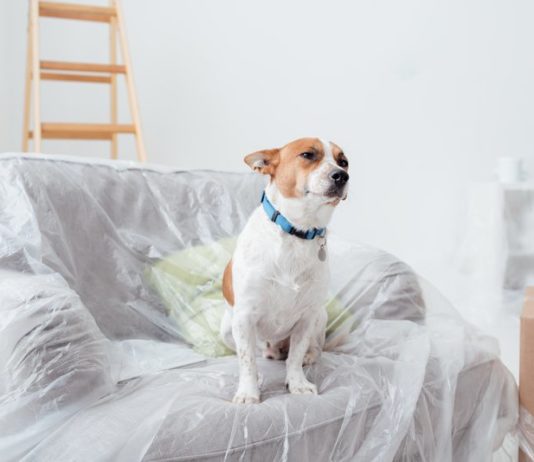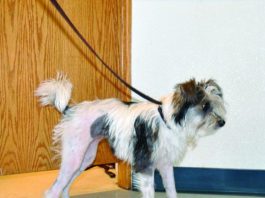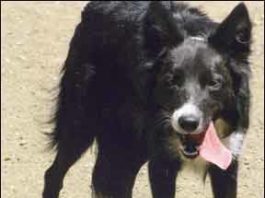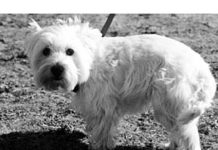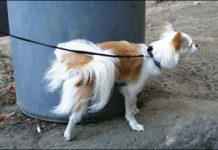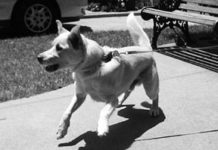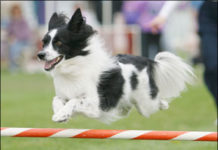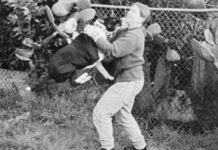Postpartum Depression and Its Effect on the Dog
As a trainer and behavior consultant, I am always ready to provide all sorts of helpful information and internet links on the subject of bringing home a new baby to meet the dog. But I can honestly say that I never considered the emotional and hormonal component of the new mom and how it would affect her relationship with her pets.
Calmative Herbs for Canine Panic Attack Occurrences
Dark clouds boil on the horizon, and a slow rumble of distant thunder delivers a slight vibration in the window panes. Jake, a large long-haired Chow-mix, is already nervous. He paces the living room, wild-eyed and panting, his body trembling with anticipation of the first dreaded clap of thunder. When it strikes, he tries to hide under the coffee table, and just like last time, he is too big to fit. The very same vase that was glued together after Fourth of July is reduced to a heap of jagged shards.
5 Ways to Stop Dogs from Urine-Marking in the House
Marking is not the same behavior as my bladder is full and I have to pee." Housetraining is just a matter of teaching your dog when and where to relieve himself. In contrast
When Your Dog Hates Being Touched
not training. Proceed more slowly
Managing Canine Behavior
September can be confusing for dogs who have grown accustomed to the constant attention of human friends over the summer. This is an especially difficult time for puppies, acquired in June, who have never been left alone for as many as eight to 10 hours a day. Suddenly the pup is abandoned by the pack, and an animal who would rarely be alone for long periods in his natural environment is left to his own devices for several hours at a time. Small wonder that this is the time when housetraining commonly breaks down, destructive behavior erupts, human tempers flare, and dogs are either banished to backyard isolation, returned to breeders, or dumped at animal shelters.
Hannah’s Change of Heart
Hannah was a normal, healthy Labrador Retriever puppy: happy, boisterous, playful, and always willing to eat. Hannah’s owner, Connecticut resident Anne Hassett, bought Hannah when the pup was seven weeks old. Hassett trained, socialized, and loved the golden pup. A field-line Labrador, Hannah hunted on the weekends and enjoyed the comfy life of a companion Lab weekdays. Hannah was well known in hunting circles for her steady, easy-going temperament, the coveted hallmark of the Labrador breed. Hassett considered breeding her, and had the dog examined and tested for genetic diseases.
Solutions for Reactive Dog Behavior
At some point in our lives, some of us find ourselves living with a difficult dog, one whose behavior challenges our patience, and exhausts our training knowledge – and opens our hearts and eyes to a new, better way of training. This is the story of one such dog and her very knowledgeable dog owner. Together, they reached an entirely new and higher level of dog training skills, thanks to the owner’s life-altering experiences with a reactive dog who wasn’t fit to compete in the career intended for her: Flyball. Flyball is not the sport for everyone. It is a relay team event, which means you have to commit to training and competing with your dog and other dogs and dog owners as a team, and you have to have an appreciation for over-the-top dogs and the resulting cacophony of sounds. In flyball, a team of four dogs race, one after the other, leaping a series of hurdles, throwing their bodies against a spring-loaded box that ejects a tennis ball, snatching the ball, and hurtling their bodies back down the row of jumps to where their next teammates strain to be released for their turns. The fastest team wins.
Is Your Dog Afraid of Thunder?
Everyone knows a thunderstorm horror story. A terrified dog leaps off a balcony or breaks through a plate glass window before jumping a fence, running into traffic, and meeting an unhappy fate. Or the animal simply disappears and is never seen again. More common and just as distressing are the panic attacks that overcome stay-at-home dogs when thunder roars or the neighbors light firecrackers. Conventional veterinary medicine treats thunderstorm and other noise phobias with powerful tranquilizers or psychoactive drugs, none of which cure the patient and all of which have adverse side effects.
Trying To Ease Your Dog’s Stress
Stress. Everyone knows what it feels like. Tight shoulders. Headache. Insomnia. Upset stomach. Everyone knows what can trigger it. Rush hour traffic. Deadlines. An insensitive boss. A toddler having a day of tantrums, unexpected bills, or taxes. We also know that too much stress can actually make us ill. Ulcers and high blood pressure are prime examples. A recent study noted that 19 percent of employees who call in sick on any particular day do so because they simply felt they needed a day off.
Causes of Reactive Dog Behavior and How to Train A Reactive Dog
“Reactive” is a term gaining popularity in dog training circles – but what is it, exactly? In her book Clinical Behavioral Medicine for Small Animals, Applied Animal Behaviorist Karen Overall, M.A., V.M.D., Ph.D., uses the term to describe animals who respond to normal stimuli with an abnormal (higher-than-normal) level of intensity. Take a deep breath and relax. We have positive training solutions for dogs who "go off" or "lose it" in certain circumstances.
Why Do Dogs Howl?
Howling is one of the many ways that dogs communicate. It can be a territorial declaration, signal excitement at the start of a walk. or just communicating with dogs in the area.
Involuntary Urination
When my dog Popcorn woke up one morning many years ago in a puddle of urine, I panicked, certain that only a deadly illness could cause this perfectly housetrained dog to wet her bed. I rushed her to the vet, where he did a thorough physical exam and urinalysis. I can still remember the relief I felt when my vet told me it appeared to be a simple case of incontinence. As it turns out, incontinence, which is defined as involuntary urination, is quite common in dogs, especially spayed females, where about one in five dogs (20 percent) is affected.


